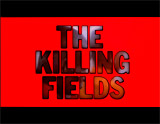
|
The Killing
Fields (1984, UK)
In director Roland Joffe's war-drama regarding the
1975 evacuations and airlifts (staged) from Cambodia and the aftermath
of the US' withdrawal (Cambodian genocide from 1975 to 1979):
- the film's opening (voice-over) by the central character
during the titles - NY Times reporter Sydney Schanberg (Sam
Waterston): "Cambodia. To many Westerners, it seemed a paradise.
Another world, a secret world. But the war in neighboring Vietnam
burst its borders, and the fighting soon spread to neutral Cambodia.
In 1973, I went to cover this side-show struggle as a foreign correspondent
of The New York Times. It was there in the war-torn country
side amidst the fighting between government troops and the Khymer
Rouge guerrillas, that I met my guide and interpreter, Dith Pran,
a man who was to change my life in a country that I grew to love
and pity"
- the narration continued with an early August 1973
excerpt from a Voice of America radio announcer about news
on the political front in the US - Nixon's Watergate Scandal: "So
here we go with Voice of America. News for Southeast Asia.
It's 6:45 and a partly cloudy morning here. Clouds too in Washington.
President Nixon has announced that he will address the nation on
the Watergate case within the next few days. The speech will be Mr.
Nixon's first comments since May on the scandal that has resulted
in resignations and nearly paralyzed the White House staff. It has
also led to a tense confrontation, and perhaps a constitutional crisis,
with Senate investigators and the special Watergate prosecutor. His
speech was announced after the Gallup Poll disclosed that Mr. Nixon's
popularity had fallen to the lowest point for an American President
in 20 years..."
- the deep friendship that developed between Cambodian
journalist and interpreter-translator Dith Pran (Haing S. Ngor) with NY
Times reporter Sydney Schanberg
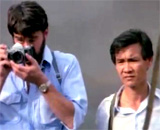
|
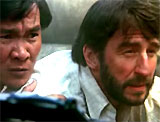
|
|
Dith Pran with NY Times Reporter Sydney Schanberg
|
- the re-enactment of the chaotic, last-minute roof-top
evacuations of the embassy by helicopter from Cambodia's capital,
Phnom Penh in 1975
- subsequently, Dith Pran's experiences when seized
by the totalitarian Khymer Rouge and imprisoned in a "re-education
camp"
- the scene of Schanberg's acceptance in 1976 of the
Pulitzer Prize for coverage of the Cambodian conflict - to which
he gave credit to Pran: "I'm very pleased to accept this on
behalf of Dith Pran and myself"
- the sequence of Dith Pran's escape from Cambodia and
the Khymer Rouge through apocalyptic scenes of massacres and atrocities
against Cambodian citizens, most memorably wading through water-filled
shallow graves with thousands of skulls and decomposing corpses in
the infamous 'killing fields' of the Pol Pot regime
- the resolution of Dith Pran's escape, when he sighted
a Red Cross camp, and crossed over to the Thailand border and found
safety and security working there
- the sequence of Dith Pran's tearful reunion with reporter
Sydney at a Red Cross camp on the border in the film's finale, when
a car carrying Sydney pulled into the courtyard and Dith Pran emerged
from one of the rehab buildings: (Sydney: "Do you forgive me?" Dith: "Nothing
to forgive, Sydney. Nothing"), highlighted by John Lennon's
song "Imagine"
- the film's epilogue was provided in two title cards
as the camera slowly panned to the left over the rooftops, and
looked out over rice fields, followed by a still image of two refugee
children (that changed from color to black and white): ("Dith
Pran returned with Sydney Schanberg to America to be reunited with
his family. He now works as a photographer for The New York
Times where Sydney Schanberg is a columnist. Cambodia's torment
has not yet ended. The refugee camps on the Thai border are still
crowded with the children of the killing fields.")
|

Backdrop for Opening Voice-Over Narration

1975 Airlift from Cambodia
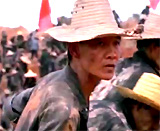
Dith Pran in The Re-Education Camp
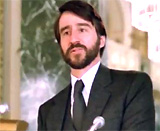
Acceptance of Pulitzer Prize
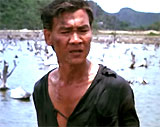
The "Killing Fields"
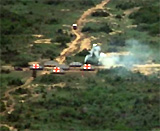
The First View of the Red Cross Camp on the Thailand Border
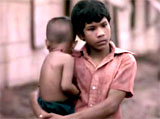
Ending: Still Image of Two Refugee Children
|








